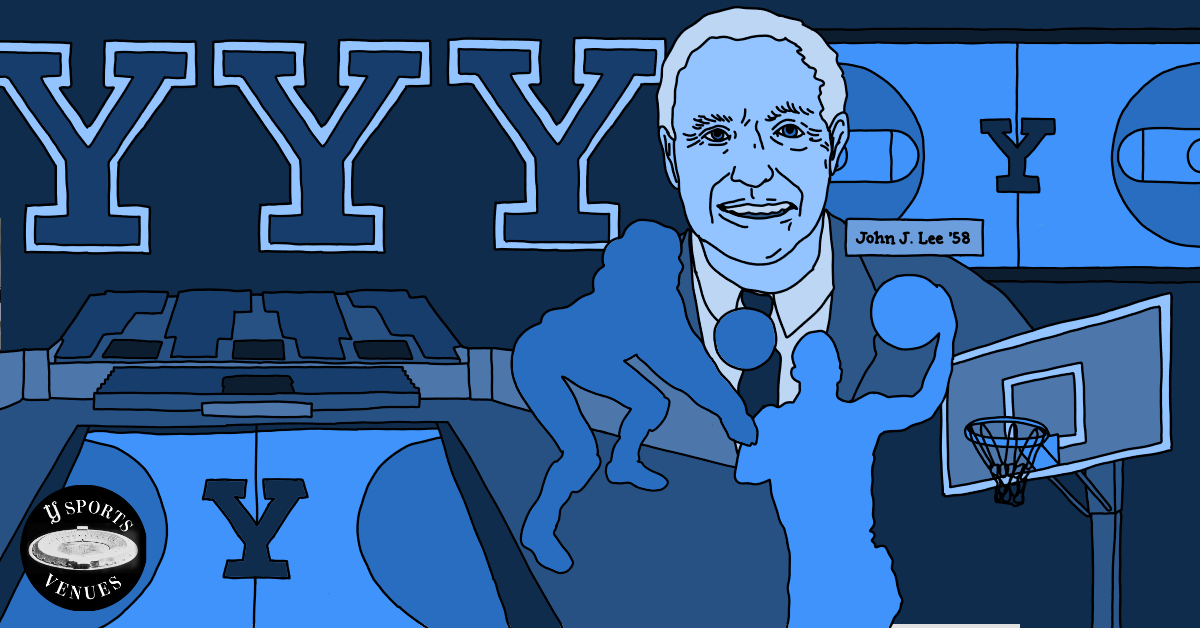Behind the Venue: Stories from the sideline at the John J. Lee Amphitheater
Home to Yale men’s and women’s basketball, volleyball and gymnastics, the John J. Lee Amphitheater inhabits a wing of the Payne Whitney Gymnasium. A scorekeeper, official and varsity captain weigh in on the amphitheater, its architecture and its atmosphere.

Zully Arias, Production and Design Editor, and Anasthasia Shilov, Illustrations Editor
“Behind the Venue” is a series of feature-form articles that dives into the history, character and most memorable moments of Yale’s various athletic forums — from stadiums and fields to pools and boathouses. While not all articles in the series will resemble one another, all attempt to take a deeper look into how these places came to be and how they have fared over time. This article is the 10th in the series.
When Payne Whitney, class of 1898, died in 1927, his wife, Helen Hay Whitney, donated six million dollars to Yale with the stipulation that it be used to build a cathedral.
The University, however, needed a new gymnasium more than another church. When Yale completed construction of the building, staff took Whitney on a tour of its exterior. Its gothic architecture and nine-story tower were reminiscent enough of a cathedral to convince her.
Almost a century later, Payne Whitney Gymnasium lives up to its nickname of “the Cathedral of Sweat.” By volume, it is the second largest athletic center in the world. Home to Yale men’s and women’s basketball, volleyball and gymnastics, the John J. Lee Amphitheater inhabits the east wing of Payne Whitney.
In 1996, Yale named the gym after men’s basketball alumnus John J. Lee ’58 GRD ’59, and JLA today is the seventh-oldest NCAA college basketball arena still in use — and the third-oldest in the Ivy League, behind Harvard’s Lavietes Pavilion and Penn’s Palestra.

The early days
When the gym first opened to students on December 10, 1932, the then-unnamed amphitheater was Yale’s home for basketball, tennis, boxing, wrestling and fencing. Its state-of-the-art features included a skylight as its primary light source, basketball hoops that could fold away during other athletic competitions and a green canvas that acted like a turf court for tennis matches.
At its opening, the amphitheater could hold 1,600 people, “with a possibility of seating 1000 more in bleacher seats on the floor as the occasion may demand,” according to a 1932 story in the News. JLA’s current seating capacity is only slightly higher, with 1,500 permanent seats and 1,300 pull-out bleachers.
Athletic directors from schools across the country rushed to commend Yale on building the athletic monument.
“The Payne Whitney Gymnasium is undoubtedly the finest athletic plant of its kind in the world,” Major Philip B. Fleming, manager of athletics at West Point, told the News in 1932. “Every facility for indoor athletics both from the participants’ and spectators’ viewpoint is provided.”

John J. Lee ’58: The name
The amphitheater’s namesake, John J. Lee Jr., was a standout basketball player in high school, earning All-American awards in his junior and senior years. Of the 65 colleges to extend athletic offers to Lee, he chose to attend Yale because of the career prospects it would provide.
“I didn’t want to be just another college athlete with nowhere to go after he graduated,” Lee told Sports Illustrated for a 1958 cover story.
The chemical engineering major was a force to be reckoned with on the basketball court. He was selected for the All-Ivy First team in 1956, 1957 and 1958. Upon his graduation in 1958, the New York Knicks drafted Lee in the third round. Lee was the second Bulldog to be drafted to a team in the NBA, and only six have been drafted since.
Lee decided an education was more important than the big stage, however. He never played in the NBA after getting drafted and instead decided to pursue a master’s degree in chemical engineering from Yale.
As an alumni trustee of the Yale Corporation in 1993, Lee helped to collect over $1.5 billion in funds for the University, the largest such campaign in Yale’s history.

Perspectives from the sideline today
JLA houses almost 90 years’ worth of stories, and the News spoke with members of the athletic community affiliated with the arena to hear about their relationships with the space.
Tim Bennett, assistant director of strategic communications at Yale Athletics, has been working in the department for 26 years. Bennett works closely with several varsity teams — including the men’s basketball team — as a sports information director, managing statistics, media relations, social media and more.
“I fell in love with Lee Amphitheater the first time I saw it,” Bennett said. “It’s a very unique arena, and I feel the tremendous sense of history when I walk in. It provides one of the most electric atmospheres in all of college athletics. It gets really, really loud.”
JLA does not rely on the most modern equipment to keep fans engaged, like jumbotrons or large video screens found at most collegiate and professional arenas. Instead, the James Hillhouse High School Band and the Yale Precision Marching Band often provide music during breaks in basketball gameplay. Sounds from fans and the YPMB bounce off the concrete and stone walls of the amphitheater, making JLA sound like there are more fans in the seats than the arena actually fits.
While reminiscing about a men’s basketball game against Harvard in the early 2000s, Bennett remembered that, “the student section was packed, and it got so loud that then-Crimson coach Frank Sullivan tried to bring his team into the hallway to talk to them during a timeout. The referee had to go out and tell them they couldn’t do that and had to come back to their bench.”

“[JLA] just strikes you as an awesome physical structure that has been there for such a long time that can tell so many stories from so many fantastic people,” said Dave Boland, a former basketball referee and chief timing officer of Timing is Everything, the company Yale Athletics uses for official scorekeeping at JLA.
Boland, along with two other former referees, started Timing is Everything in 1996. Yale basketball first found out about Timing is Everything from the company’s first client, UConn basketball. Boland said Yale was pleased with their service, and Timing is Everything now works for 11 Yale sports.
Lorraine Duffy officiates gymnastics competitions at JLA. Duffy works NCAA gymnastics meets as well as those for private clubs. She was also previously the head coach for the University of Bridgeport’s team from 1987 to 2003.
“The thing about Yale is that you have to appreciate that architecture — it is very cool. It’s a good arena, with good seating,” Duffy said.

While some schools in bigger conferences, like the SEC, have larger arenas, JLA provides a very different experience, Duffy said. Instead of light shows or smoke machines to excite the crowd, the historical qualities of the arena speak for themselves.
As a Connecticut native and veteran in the gymnastics world, Duffy enjoys indulging in the amphitheater’s rich history.
“When they do the alumni meet or the Don Tonry invitational, you get to go up to the trophy room and see the trophies and all the old pictures,” she said.
JLA’s extensive trophy room and rich history was a change of scenery for Yale volleyball captain and outside hitter Ellis DeJardin ’22. Coming from a small high school, she conceded that an arena such as JLA was intimidating when she first started playing for Yale: A 90-year-old amphitheater beats out a high school gymnasium in both capacity and luxury.
“I feel so fortunate to get to play in such a beautiful facility,” DeJardin said. “I honestly probably take it for granted.”

Fans sitting near the court in JLA’s outstretched wooden bleachers have the chance to engage closely with players celebrating between points. When the Blue and White beat Princeton for the 2019 Ivy League crown, there were 816 seats filled in the bleachers.
“It benefits both parties when we get a good crowd to show up,” said DeJardin. “The fans fire us up a bit more, and then we start playing a bit better and putting on more of a show for them.”
The first competition at JLA took place on December 2, 1932, when Yale men’s basketball defeated an alumni team, 38–16.
Melanie Heller | melanie.heller@yale.edu










